Product Services
Featured product
Products/Services
-
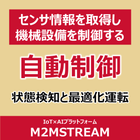
Automatic control(3)
Introducing an automatic control system linked with IoT sensors. ● System Overview The automatic control system linked with IoT sensors is an advanced system that utilizes real-time data collected from a variety of IoT sensors installed in factories, facilities, and infrastructure equipment to enable remote monitoring and automatic control of equipment via the cloud. This system allows for constant awareness of equipment status, enabling early detection of abnormalities and efficient operational control from a distance. The IoT sensor-linked automatic control system enhances safety, efficiency, and cost-effectiveness, serving as an important solution for next-generation smart infrastructure operations. ● Key Features Real-time remote monitoring Automatic control functionality Abnormality detection and alert notifications Data accumulation and analysis Support for diverse environments and sensors ● Benefits of Implementation Improved operational efficiency Prevention of failures and troubles Rapid decision-making and response Energy savings and cost reduction ● Example Use Cases Detection of abnormalities in pumps and drainage equipment with automatic stop/start Detection of condensation in warehouses with automatic stop/start of ventilation Efficient management and automatic adjustment of building air conditioning and lighting
-
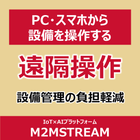
Remote control(3)
Introducing a remote control system linked with IoT sensors. ● System Overview This cloud system is a new era equipment management solution that allows remote monitoring via IoT sensors, as well as the operation of machinery and equipment located in remote areas from devices such as computers and smartphones. By utilizing a cloud platform, it enables the confirmation and control of equipment status anytime and anywhere, significantly improving the efficiency and safety of equipment operations. This system achieves next-generation equipment management by combining the "visualization" provided by IoT with the "immediate operability" of remote control, ensuring both safety and efficiency. ● Key Features Real-time remote monitoring Remote operation from PC and smartphone Alert and notification functions Data accumulation and visualization Secure access management ● Benefits of Implementation Centralized management from remote locations Faster maintenance and response Improved operational efficiency and productivity ● Example Use Cases Monitoring of factory wastewater treatment equipment and remote valve switching Remote control of air conditioning and lighting systems in building management Management of remote infrastructure facilities and emergency response
-
設備保全(8)
設備保全
-
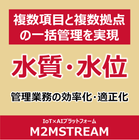
Water quality and water level(15)
Introducing examples of IoT utilization related to water quality and water level. ● System Overview The water quality and water level monitoring system using IoT sensors automatically collects information such as water quality and water level in real-time from multiple sensors installed in various locations, including rivers, reservoirs, factories, facilities, and agricultural water sources, and sends it wirelessly to the cloud. The acquired data can be accessed anytime and anywhere via a computer or smartphone over the internet, enabling remote situation awareness, anomaly detection, and operational optimization. ● Main Features Real-time remote monitoring Alert and notification functions Data accumulation and report output Support for multi-site and multi-point measurements Integration with other systems and automatic control ● Benefits of Implementation Reduction and efficiency of manual labor Early detection of anomalies and rapid response Operation and optimization based on data Improvement of safety and sustainability ● Examples of Utilization Scenarios Environmental measures through wastewater and water supply monitoring in factories and water supply and drainage facilities Simplification of monitoring and management of remaining water levels in water tanks and reservoirs in public facilities and apartment complexes Early detection and countermeasures through continuous monitoring in high contamination risk sites Remote monitoring of water quality and water level in rivers, dams, and irrigation channels, and flood warning Management of water quality and water level in irrigation sources and hydroponic cultivation facilities in the agricultural sector.
-
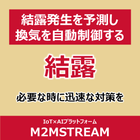
Condensation(1)
Here are examples of IoT applications related to condensation. ● System Overview In recent years, due to global warming, the damage caused by summer-type condensation has become significant, increasing the importance of condensation countermeasures throughout the year. This system installs temperature, humidity, and surface temperature sensors on stored items and equipment to collect data from the surrounding environment in real-time. The collected data is automatically transmitted wirelessly to the cloud, where the system calculates the dew point temperature and assesses the risk of condensation occurrence automatically. ● Main Functions Real-time remote monitoring Automatic assessment and notification of condensation risk Alert function and automatic control Data accumulation and analysis Support for multi-site and multi-point observation ● Benefits of Implementation Prevention of condensation occurrence and rapid response Significant labor savings in maintenance and management tasks Extension of equipment lifespan and improvement of quality Cost reduction and promotion of energy-saving measures Establishment of a data-driven maintenance system ● Example Use Cases Quality control of products and raw materials in factories and warehouses, monitoring the risk of condensation troubles in storage environments Prevention of condensation on floors, walls, and equipment in logistics centers and warehouses, and response before trouble occurs Environmental monitoring in high-quality management settings such as food factories and pharmaceutical factories
-
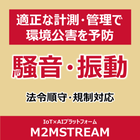
Noise and vibration(3)
Introducing examples of IoT utilization related to noise and vibration. ● System Overview The IoT sensor-based noise and vibration monitoring system automatically transmits data from noise and vibration meters installed at sites, facilities, and infrastructure to the cloud using wireless communication. Administrators can remotely monitor the site conditions in real-time from a computer or smartphone, enabling visualization of noise and vibration levels and long-term data accumulation. The IoT noise and vibration monitoring system is being implemented in a wide range of locations, achieving more efficient and timely environmental management. ● Main Features Real-time remote monitoring Alert and notification functions Data accumulation and graphing Event recording and direction detection Secure access management ● Benefits of Implementation Visualization of site conditions Faster abnormal detection and early response Reduction of operational costs and work time Automation of reporting and record-keeping tasks ● Examples of Utilization Scenarios Monitoring the surrounding environment and addressing complaints at construction sites Monitoring the operation of factory equipment and infrastructure, and preventing vibration issues Noise management and safety measures in office buildings and residential areas Management in sites where compliance with environmental standards and pollution control is required.
-
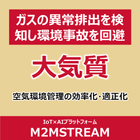
Air quality(0)
Here are examples of IoT applications related to air quality. ● System Overview The gas continuous measurement system for VOCs (volatile organic compounds) and other gases is installed in factories, research facilities, and indoor spaces. Gas sensors measure the gas concentration in real-time and automatically transmit the data wirelessly. Administrators can remotely view and manage the data from PCs or smartphones, enabling thorough monitoring of safety management and air quality in the field. This system is widely implemented in environments that require advanced safety management, labor reduction, and environmental measures. ● Key Features Real-time continuous monitoring Alert and notification functions Data accumulation and visualization Remote operation and automatic control (expandable) Support for multiple locations and measurement points ● Benefits of Implementation Ensuring a safe working environment Early detection of abnormalities and rapid response Improved operational efficiency and labor reduction Compliance and environmental measures ● Example Use Cases Air quality management in factories and research facilities; safety monitoring in organic solvent usage sites Health hazard measures in VOC-emitting areas such as paint and adhesive applications Maintaining environmental standards in laboratories, hospitals, and clean rooms Auditing and reporting of emissions in ink, cleaning agents, and petrochemical plants Ventilation management in buildings and facilities, detection of odor anomalies, and automatic ventilation control
-
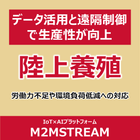
Land-based aquaculture(0)
Here are examples of IoT applications related to land-based aquaculture. ● System Overview The cloud-based monitoring system for land-based aquaculture farms and seedling production facilities collects real-time data from various sensors (such as water temperature, dissolved oxygen, pH, turbidity, and salinity) installed in rearing tanks and enclosures, and automatically transmits it to the cloud wirelessly. Without needing to visit the site, users can check water quality and equipment status anytime and anywhere from a PC or smartphone, enabling optimization of aquaculture operations through alert notifications and data analysis. ● Key Features Real-time remote monitoring Alert and notification functions Data accumulation and graphing Remote operation and automatic control Integration with video monitoring Customizability and scalability ● Benefits of Implementation Improved accuracy in water quality and environmental management Reduction in workload and labor costs Increased productivity and quality Cost reduction and profit enhancement Traceability and business expansion ● Example Use Cases Monitoring the growth of fish and crustaceans and managing automatic feeding in land-based aquaculture farms Environmental management of water quality and temperature in seedling production facilities (such as fry, spat, and seedlings) Disease prevention and mortality rate reduction through water temperature adjustment and pH management in tanks Reduction of site visits and business trips to production sites, and integrated management of multiple aquaculture locations.
-

hot spring(2)
Here are examples of IoT utilization related to hot springs. ● System Overview The IoT sensor-based hot spring monitoring system automatically transmits data from various sensors (thermometers, flow meters, water quality sensors, etc.) installed in hot spring areas and facilities to the cloud wirelessly, allowing for real-time remote monitoring and management via devices such as computers. This enables efficient visualization of the resource status of hot springs and the operational state of facilities, significantly reducing maintenance efforts. The IoT hot spring monitoring system is being adopted in various settings as a modern management method that ensures sustainable operation, safety, cost reduction, and labor-saving in hot spring areas. ● Main Features Real-time remote monitoring Alert and notification functions Data accumulation and graphing Remote operation and automatic control functions Support for multiple locations and measurement points ● Benefits of Implementation Sustainable use of hot spring resources Labor-saving and efficiency Facility cost and energy-saving measures Prevention of malfunctions and troubles ● Example Use Cases 24-hour remote monitoring of hot spring supply and distribution facilities in establishments and inns Monitoring the impact on hot spring resources during geothermal power development and supporting environmental assessments Comprehensive resource management and sustainable utilization measures for multiple hot spring areas by local governments.
-

Electricity(0)
Here are examples of IoT applications related to electricity. ● System Overview The power usage monitoring system using IoT sensors is designed to collect real-time power consumption data from power meters and sensors installed in distribution boards and various equipment in factories, buildings, public facilities, and offices. This data is automatically sent and stored in the cloud. Users can remotely check the data from computers or smartphones, achieving "visualization" of energy and improving management efficiency. The IoT power usage monitoring system contributes to achieving "energy conservation, operational efficiency, cost reduction, and safe operations" across various industries and facilities. ● Key Features Real-time remote monitoring Data accumulation and graphing Alert and notification functions Scalability and customization No wiring required; easy installation ● Benefits of Implementation Optimization of power usage and cost reduction Early detection of anomalies and stable operation Advancement of DX (Digital Transformation) and energy management ● Example Use Cases Constant monitoring of power usage in factories and buildings and energy-saving measures Analysis and optimization of energy loss at production lines and equipment units Energy conservation education and awareness-raising in public facilities and educational settings Efficient response to abnormalities and maintenance, as well as prevention of troubles before they occur.
-

Soil(0)
Here are examples of IoT applications related to soil. ● System Overview The soil monitoring system, which can be remotely monitored using IoT sensors, utilizes various soil sensors (e.g., moisture, temperature, electrical conductivity, pH, etc.) installed in agricultural fields, plots, and green infrastructure to acquire local soil environment data in real-time and automatically transmit it wirelessly to the cloud. Administrators and users can remotely monitor and analyze the local soil conditions anytime and anywhere through smartphones or computers. The IoT soil monitoring system is being implemented not only in crop production sites but also in various fields such as urban infrastructure and environmental conservation. ● Main Features Real-time remote monitoring Alert and notification functions Data accumulation and report output ● Benefits of Implementation Improvement of crop yield and quality Reduction of labor costs and workload Early detection of anomalies and rapid response Efficient use of resources and cost reduction ● Example Use Cases Monitoring soil moisture in agricultural fields and controlling irrigation and fertilization Optimal management of soil and nutrient solutions in plant factories and greenhouse cultivation Monitoring the condition of soil (ground) in rivers, lakes, and environmental infrastructure facilities Assessment of soil health in a wide range of areas such as parks, green spaces, and urban infrastructure.


